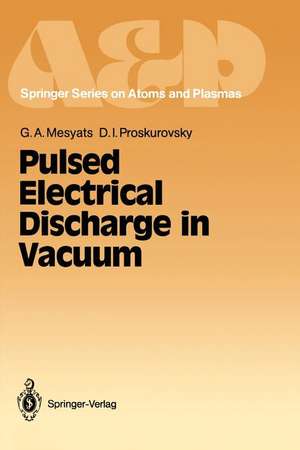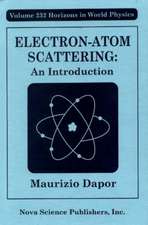Pulsed Electrical Discharge in Vacuum: Springer Series on Atomic, Optical, and Plasma Physics, cartea 5
Autor Gennady A. Mesyats, Dimitri I. Proskurovskyen Limba Engleză Paperback – 12 feb 2012
Din seria Springer Series on Atomic, Optical, and Plasma Physics
- 18%
 Preț: 1007.65 lei
Preț: 1007.65 lei - 18%
 Preț: 942.63 lei
Preț: 942.63 lei - 24%
 Preț: 833.23 lei
Preț: 833.23 lei - 15%
 Preț: 641.20 lei
Preț: 641.20 lei -
 Preț: 384.86 lei
Preț: 384.86 lei - 24%
 Preț: 810.75 lei
Preț: 810.75 lei - 18%
 Preț: 786.04 lei
Preț: 786.04 lei - 18%
 Preț: 793.94 lei
Preț: 793.94 lei - 15%
 Preț: 649.54 lei
Preț: 649.54 lei - 18%
 Preț: 1023.11 lei
Preț: 1023.11 lei - 18%
 Preț: 1006.87 lei
Preț: 1006.87 lei - 18%
 Preț: 1117.03 lei
Preț: 1117.03 lei - 15%
 Preț: 642.36 lei
Preț: 642.36 lei - 18%
 Preț: 998.82 lei
Preț: 998.82 lei - 18%
 Preț: 781.77 lei
Preț: 781.77 lei -
 Preț: 382.75 lei
Preț: 382.75 lei - 15%
 Preț: 650.37 lei
Preț: 650.37 lei - 18%
 Preț: 792.03 lei
Preț: 792.03 lei - 24%
 Preț: 975.64 lei
Preț: 975.64 lei - 24%
 Preț: 790.66 lei
Preț: 790.66 lei - 18%
 Preț: 945.79 lei
Preț: 945.79 lei - 18%
 Preț: 999.76 lei
Preț: 999.76 lei - 18%
 Preț: 883.90 lei
Preț: 883.90 lei - 18%
 Preț: 784.92 lei
Preț: 784.92 lei - 18%
 Preț: 1006.06 lei
Preț: 1006.06 lei - 18%
 Preț: 882.19 lei
Preț: 882.19 lei - 18%
 Preț: 955.88 lei
Preț: 955.88 lei - 18%
 Preț: 748.77 lei
Preț: 748.77 lei - 18%
 Preț: 1015.23 lei
Preț: 1015.23 lei - 15%
 Preț: 582.12 lei
Preț: 582.12 lei -
 Preț: 390.25 lei
Preț: 390.25 lei -
 Preț: 389.49 lei
Preț: 389.49 lei - 18%
 Preț: 945.79 lei
Preț: 945.79 lei -
 Preț: 384.48 lei
Preț: 384.48 lei
Preț: 388.90 lei
Nou
Puncte Express: 583
Preț estimativ în valută:
74.43€ • 76.89$ • 61.94£
74.43€ • 76.89$ • 61.94£
Carte tipărită la comandă
Livrare economică 26 martie-09 aprilie
Preluare comenzi: 021 569.72.76
Specificații
ISBN-13: 9783642837005
ISBN-10: 364283700X
Pagini: 308
Ilustrații: XI, 293 p.
Dimensiuni: 155 x 235 x 16 mm
Greutate: 0.44 kg
Ediția:1989
Editura: Springer Berlin, Heidelberg
Colecția Springer
Seria Springer Series on Atomic, Optical, and Plasma Physics
Locul publicării:Berlin, Heidelberg, Germany
ISBN-10: 364283700X
Pagini: 308
Ilustrații: XI, 293 p.
Dimensiuni: 155 x 235 x 16 mm
Greutate: 0.44 kg
Ediția:1989
Editura: Springer Berlin, Heidelberg
Colecția Springer
Seria Springer Series on Atomic, Optical, and Plasma Physics
Locul publicării:Berlin, Heidelberg, Germany
Public țintă
ResearchCuprins
1. Introduction.- 2. Review of Vacuum Breakdown and Discharge Studies.- 2.1 The Electrode Surface in a Vacuum Discharge.- 2.2 Vacuum Insulation, Properties and Breakdown.- 2.3 Kinetics of Vacuum Electrical Breakdown.- 2.4 Field Electron Emission to Vacuum Breakdown Transition.- 2.5 Hypotheses on Vacuum Breakdown Initiation.- 2.6 Spark Stage of Vacuum Breakdown.- 2.7 The Discharge Arc Stage. The Cathode Spot.- 3. Experimental Equipment and Techniques.- 3.1 Electrical Measurement Techniques.- 3.2 Diagnostics of the Radiation that Accompanies Breakdown.- 3.3 Vacuum Equipment.- 3.4 Preparation and Examination of Electrode Surfaces.- 4. Pulsed Nanosecond Breakdown of Vacuum Gaps.- 4.1 Time Characteristics of the Pulsed Vacuum Breakdown.- 4.2 Study of Light Emission at Pulsed Breakdown.- 4.3 Electrode Erosion Studies.- 4.4 Nature of the Discharge Current at Breakdown.- 4.5 Mechanism of Pulsed Breakdown of Vacuum Gaps.- 5. Cathode Processes in a Pulsed Vacuum Discharge.- 5.1 EEE Initiation by High-Density FEE Current.- 5.2 Erosion of Point Cathodes.- 5.3 EEE Current Density Measurements.- 5.4 Microstructure of the Cathode Surface.- 5.5 The Contribution of Droplet Ejection to Cathode Erosion.- 5.6 Pressure in the Emission Zone.- 5.7 Formation of Cathode Microstructure.- 6. Cathode Flare Plasma.- 6.1 Velocity of CF Plasma Expansion.- 6.2 CF Plasma Parameters.- 6.3 EEE Current Effect on the Dynamics of the Plasma Light Emission.- 6.4 A Model for CF Plasma Expansion.- 7. Current Passage in the Spark Stage of Breakdown.- 7.1 Electron Emission from CF Plasma into Vacuum.- 7.2 Electron Emission from CF Plasma, Experimental Studies.- 7.3 Current-Voltage Characteristics of a Single-CF Diode.- 7.4 Dynamics of the CF Electron Emission Boundary.- 7.5 CF Plasma Potential Distribution and Plasma Emissive Properties.- 7.6 Spark Current Between Broad-Area Electrodes.- 8. Formation of New Emission Centers on the Cathode.- 8.1 Mechanisms of New EC Formation Under the Plasma.- 8.2 New EC Formation and Operation Under Cathode Plasma.- 8.3 “Screening” Effect and Electron Beam Structure in a Diode.- 9. Anode Processes in the Spark Stage of Vacuum Breakdown.- 9.1 Anode Heat Conditions.- 9.2 Surface Structure of the Anode in the Discharge Zone.- 9.3 Formation of Anode Flares.- 9.4 X-Radiation Generated at the Anode.- 10. Fast Processes at DC Breakdown of Vacuum Gaps.- 10.1 Electrical Study of DC Breakdown.- 10.2 Optical Studies.- 10.3 Comparison with Results of Other Investigations.- 10.4 EEE Initiation at DC Breakdown.- 11. Nonstationary Processes in the Vacuum Arc Cathode Spot.- 11.1 The Motion of Vacuum Arc Cathode Spots.- 11.2 Response of the Vacuum Arc to Current Transients.- 11.3 Vacuum Arcs at Threshold Currents.- 11.4 Numerical Simulation of Processes in an Explosive Emission Center.- 11.5 Explosive Electron Emission and the Vacuum Arc Cathode Spot.- 12. Pulsed Electrical Discharge in Vacuum at Cryogenic Electrode Temperatures.- 12.1 Field Electron Emission at Low Cathode Temperatures.- 12.2 Field Emission Current Preceding the Explosion of a Point.- 12.3 Characteristics of the Vacuum Discharge at Cryogenic Temperatures.- 12.4 Vacuum Discharge Between Electrodes Made of High-Temperature Superconductors.- References.
















